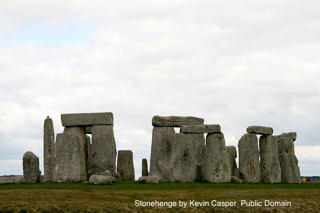While recovering from the Coronavirus, I watched a documentary about Stonehenge, the architectural mystery and astronomical wonder located eight miles north of Salisbury, England. It’s estimated that around 1600 B.C., ancients hauled massive rock pillars to that location from Southwest Wales and positioned them in two concentric circles around the center of the site. There are 30 upright stones which are up to 30 feet tall and weigh as much as 25 tons. Several are still capped by a ring of stone lintels that are secured by interlocking joints. Stonehenge looks like a series of huge stone doorways in an open field.
 Archeologists contend this unique site proves the ancients knew astronomy and enabled the residents to foretell eclipses of the sun and moon by the position of those celestial bodies in relation to the stone monuments. It’s also speculated Stonehenge may have served as an observatory where early rituals or religious ceremonies took place on specific days of the year.
Archeologists contend this unique site proves the ancients knew astronomy and enabled the residents to foretell eclipses of the sun and moon by the position of those celestial bodies in relation to the stone monuments. It’s also speculated Stonehenge may have served as an observatory where early rituals or religious ceremonies took place on specific days of the year.
Stonehenge raises many questions that remain unanswered to this day. Where exactly did the boulders come from? How did the ancients transport 25-ton rocks over miles of rugged terrain? What kind of sophisticated equipment did they have that made it possible to set the rocks as stable, upright columns and then lift and secure several on top of others? How did they know so much about astronomy? Could this possibly be evidence of a visit from intellectually superior aliens some 3500 years ago?
What I found most interesting was that no scientist, astronomer, or historian suggests that Stonehenge was a bizarre accident. No one speculates that a ferocious super-tornado spontaneously lifted those gigantic boulders and arranged them in their intricate pattern. No one proposes that perhaps an enormous subterranean buildup of natural gas produced a gigantic explosion and that a big bang resulted in the massive rocks landing on top of each other in a perfect circle.
No, human beings instinctively know the difference between random results and deliberate design. The intricate formation of Stonehenge presumes intelligent design. Archeologists speak of someone digging a circular ditch, hauling stones from a distant location, and arranging them for a definite purpose. They don’t even entertain a theory that it could have been unintentional.
The design of the universe is many times more complex than Stonehenge. Geneticists insist our DNA contains more organized information than the Encyclopedia Brittanica. The human body is a thousand times more complicated than any man-made machine. What kind of logic examines Stonehenge and assumes intelligent design and then surveys the universe and concludes it’s accidental? That’s not logic; that’s an absurdity. That’s sinful, intellectual pride, rebelling against God’s truth. It proves the old adage, “There is no idea so absurd that if repeated often enough will eventually come to be believed.”
No wonder Scripture says, “The fool says in his heart, ‘there is no God…’” (Psalm 14:1). The precise design and function of the universe affirm the truth of Psalm 19:1: “The heavens declare the glory of God; the skies proclaim the work of his hands.”
In light of today’s worldwide unrest, we would be wise to seriously study the following passage of Scripture from the book of Romans. “The wrath of God is being revealed from heaven against all the godlessness and wickedness of people, who suppress the truth by their wickedness, since what may be known about God is plain to them, because God has made it plain to them. For since the creation of the world God’s invisible qualities—his eternal power and divine nature—have been clearly seen, being understood from what has been made, so that people are without excuse” (Romans 1:18-20).
.
Follow BobRussellKY on Twitter and LIKE the Bob Russell page on Facebook

